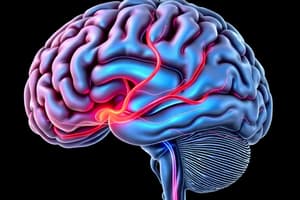Podcast
Questions and Answers
Which nursing intervention helps maintain cerebral perfusion in an unconscious patient?
Which nursing intervention helps maintain cerebral perfusion in an unconscious patient?
- Monitor ABGs and respiratory rate (correct)
- Encourage deep breathing exercises
- Administer sedatives for comfort
- Elevating the head of the bed to prevent choking
What is a common sign indicating increased intracranial pressure (ICP) in a stroke patient?
What is a common sign indicating increased intracranial pressure (ICP) in a stroke patient?
- Improved motor function
- Increased respiratory rate
- Elevated body temperature
- Drowsiness and lethargy (correct)
In managing a stroke patient, which position should the nurse place the patient initially?
In managing a stroke patient, which position should the nurse place the patient initially?
- Side-lying position to reduce choking risk (correct)
- Prone position to alleviate pressure
- Sitting position to assist with breathing
- Supine position to monitor vitals
What is a potential complication associated with impaired breathing in stroke patients?
What is a potential complication associated with impaired breathing in stroke patients?
Which cardiac change may present in a stroke patient?
Which cardiac change may present in a stroke patient?
Which method is effective in assessing motor function in stroke patients?
Which method is effective in assessing motor function in stroke patients?
How can a nurse evaluate the swallowing ability of a stroke patient?
How can a nurse evaluate the swallowing ability of a stroke patient?
Which sign indicates a potential risk for aspiration in a stroke patient?
Which sign indicates a potential risk for aspiration in a stroke patient?
Flashcards are hidden until you start studying
Study Notes
Maintaining Cerebral Perfusion During Stroke
- Respiratory Monitoring:
- Monitor for rapid respirations, crackles, wheezes, and respiratory acidosis.
- Suction as needed, especially with an artificial airway.
- Minimize prolonged suctioning to avoid increased intracranial pressure (ICP).
- Initially position the patient on their side to reduce choking risk.
- Oxygen Administration:
- Administer oxygen as prescribed to prevent hypoxia and hypercapnia, which worsen cerebral ischemia and ICP.
- Neurological Monitoring:
- Closely assess mental status, level of consciousness (LOC), and movement for signs of increased ICP, a leading cause of stroke-related death.
- Evaluate motor function through strength and reflex testing.
- Assess for pain, headache, decreased strength, and sluggish pupillary reflexes.
- Evaluate swallowing for signs of an absent gag reflex, a major aspiration risk.
- Observe for a positive Babinski sign and decerebrate or decorticate posturing, indicating widespread brain damage.
- Cardiac Monitoring:
- Monitor for stroke-related cardiac dysrhythmias like bradycardia, premature ventricular contractions (PVCs), tachycardia, and atrioventricular (AV) block.
- Observe for ECG changes such as shortened PR interval, peaked T waves, and depressed ST segment.
- Temperature Regulation:
- Monitor body temperature for hyperthermia, a possible complication if the hypothalamus is affected.
- Fluid Balance:
- Maintain accurate input and output (I&O) records.
- Stroke can damage the pituitary gland, potentially leading to diabetes insipidus and dehydration due to excessive urinary output.
- Seizure Management:
- Monitor for seizures, a possible consequence of cerebral tissue damage or increased ICP.
- Implement seizure precautions like padded side rails to prevent injury.
- Administer prescribed anticonvulsants to prevent or treat seizures.
Studying That Suits You
Use AI to generate personalized quizzes and flashcards to suit your learning preferences.




